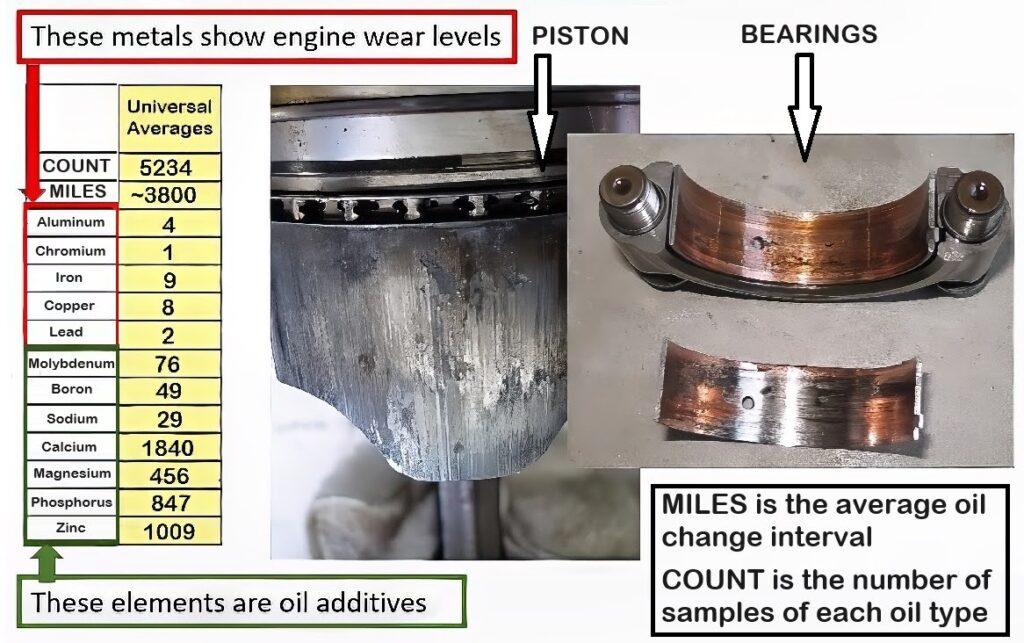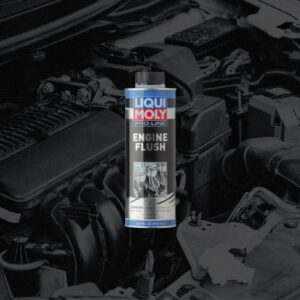The engine is your vehicle’s beating heart. You want to keep it in good shape and stay on top of any potential issues. Engine oil analysis lets you check the state of your car’s engine and its oil without taking apart the entire block to go over every component with a magnifying glass.
What is Engine Oil Analysis?
Engine oil analysis is a service that ascertains the condition of your car’s engine and its lubricant. Consisting of several tests conducted on a sample of engine oil, it searches for contaminants in the oil and premature wear in the metal components.
What Can Engine Oil Analysis Tell You?
Here are the useful pieces of information that an engine oil analysis can provide you:
Wear Metals
Wear metals are particles created when parts wear out because of abrasive wear from metal-on-metal contact or corrosive wear from acids and water in the lubricant. They include aluminum, copper, and chromium.
Engine oil analysis looks for wear metals in the lubricant and measures their levels. The composition of wear metals can show which engine parts and components they came from.
Meanwhile, wear metal levels indicate how fast the relevant parts wear out. The more metal particles in the engine oil, the more worn-out the part has become.
Aside from wear metals, engine oil analysis also assesses nitration, oxidation, and sulfation. These processes can increase the rate of wear by parts by encouraging corrosive wear.
Furthermore, the analysis measures oil additive packages that help minimize wear metal levels. Additives help grease vulnerable parts and prevent certain chemical processes that degrade metals.
Viscosity
Engine oil analysis measures the lubricant’s viscosity, which is the ability of a fluid to flow at a certain temperature. Viscosity also determines a fluid’s thickness or thinness.
Engine oil must have the right viscosity for the temperature range it finds itself in. If the lubricant becomes too thin or thick, it can cause problems for the engine. You can compare the oil’s current viscosity to the manufacturer-recommended value at a specific temperature.
TBN Retention
The Total Base Number (TBN) refers to the lubricant’s remaining ability to neutralize acids formed when the engine operates that might interfere with its role in greasing engine parts. If the TBN retention value is 50-65% lower than its original amount, you must increase the additive levels.

TAN
Engine oil analysis also evaluates the Total Acid Number (TAN), a measurement of the engine oil’s acidity. The higher the TAN value, the higher the oxidation level, leading to more acidic lubricant. In turn, excessive oxidation and acidity can wear out engine parts faster.
Contaminants
Between water, glycol-based antifreeze coolant, soot, and fuel, there’s no way you can keep engine oil pure forever. However, you can minimize contaminants and reduce their ability to interfere with the oil and prevent most engine problems.
Engine oil analysis apprises you about the amount of contaminants in the lubricant. You can take steps to prevent the contamination from getting out of hand.
Of particular concern is soot. Created when the engine inefficiently burns air-fuel mixture, high levels of soot lead to problems for engines that rely on exhaust gas recirculation (EGR) to keep emissions under control.
Then there’s engine coolant. One of the worst contaminants for oil, coolant contains water and antifreeze. Coolant can thicken the engine oil, resulting in problems like corrosion and plugged oil filters.
Fuel Dilution
Fuel is also a contaminant for engine oil. If gasoline or diesel comes into contact with oil, they can dilute the lubricant. Diluted engine oil becomes thinner and more volatile. Furthermore, its detergent additives lose effectiveness, leading to increased acidity, higher risk of corrosion, more residue deposits on metal surfaces, and other issues.
Engine Oil Analysis Benefits
How can running an engine oil analysis test on your car help you? The following are the ways it can benefit you:
Maintenance and Repair
The engine oil analysis can reveal problems with your car that you didn’t know were there. Fixing the engine becomes easier and more straightforward if you know which parts need to be replaced. Sometimes, you might catch a potential problem early enough to nip it in the bud, removing the need for a costly repair job.
Oil Change Intervals
Regular oil changes are a must, but their cost can add up over time. So how can you save money without putting your vehicle at risk?
Engine oil analysis might indicate that you can extend the interval between oil changes with no negative effect on your car. If you don’t have to replace the oil as frequently as conventional wisdom indicates, you can free up a significant chunk of your budget that usually goes to paying for oil changes.
Buying Used Cars
Are you planning to buy a used car? While it might look great, its engine might tell a different story. The seller might also oppose taking apart the engine for a thorough inspection.
Therefore, it’s recommended to run an engine oil analysis on the used vehicle. The results will reveal the engine’s condition without having to take it apart. If the test shows significant issues with the engine, such as high wear metal levels, you might want to look for another used car.
How is Engine Oil Analysis Done?
There are two approaches to engine oil analysis. Both have advantages and disadvantages, so you can choose the method that suits your situation.
One way is to do it yourself. You can purchase an engine oil analysis kit, take samples from your car’s engine, and run tests on the lubricant.
The other approach is hiring a professional engine oil analysis lab. You can send a sample of your car’s engine oil to them. They’ll run the sample through various tests and send you the result.
Speaking of samples, you can avoid making a mess by collecting engine oil with a vacuum pump. Insert the pump in the dipstick tube or crankcase filler hole, then siphon enough oil to fill the container provided by the engine oil analysis kit.

Metals:
- Lead – Cam and crank bearings.
- Iron – Cylinder liners, rings, crankshaft, camshaft, rods, valve train, oil pump gear, wrist pins, cast iron components, and gears.
- Aluminum – Pistons, main and rod bearings, pumps, thrust bearings and washers, plates and castings. Aluminum associated with silica indicates dirt.
- Copper – Main and rod bearings, oil cooler core, clutch plates, brass and bronze bushings, and roller bearing outer cage.
- Chromium – Hard metal generated from piston rings, liners, exhaust valves, shaft plating, roller bearings, needle bearings, shafts, rods, gears, stainless steel alloys.
- Tin – Bearings, brass or bronze bushings and flashing from pistons. Tin associated with lead and copper in engines indicate bearing wear.
- Nickel – Alloy valves, crankshafts, camshafts, bearings and shafts.
DIY Engine Oil Analysis Kit
A DIY kit comes with test sheets and guides on interpreting engine oil analysis results. Using them is as easy as applying a drop of warm engine oil on a sheet and looking up the appropriate guide for a pattern that matches the one made by the lubricant. While seemingly simplistic, the process can tell you about the engine’s fuel efficiency, the oil’s remaining lifespan, and the presence of any contaminants.
Mail-In Engine Oil Analysis Kit
Mail-in kits usually have a small container for the engine oil sample. They also have a label, which you must fill out with information about the sample.
Some kits include another container for shipping purposes. Pack the sample container into this container and mail it to the company. You’ll likely receive the engine oil analysis results in a few days.
True Story: Saving the Engine on a Mustang by Richard McCuistian, ASE Certified Master Automobile Technician
One Mustang owner decided to give oil analysis a try. When he got his first report back, he noticed excess aluminum.
Later that same year, he sent another sample to be analyzed and the report showed the aluminum content had nearly doubled. He went on to say this: “I took my vehicle to a repair shop and explained the situation to the service advisor. He said he really didn’t think it was the timing chain, since the vehicle only had 109,000 miles on it and ran so good. I requested that his team check the oil pressure and use a borescope to check the timing chain and tensioners. I received a call back about a day later and was informed that the timing chain guides were worn down, which ultimately would have led to possible catastrophic engine failure. The chains had worn through the plastic guides and into the aluminum backing on the guides. These reports basically saved me from a costly motor rebuild or replacement even when the vehicle wasn’t displaying any tangible symptoms.”
Where to Get Replacement Parts for Your Vehicle
Running an engine oil analysis on your vehicle can help you single out faulty components.
If you’ve confirmed that there are inoperative parts in your vehicle, it’s a good idea to replace them as soon as possible. Fortunately, finding high-quality yet affordable replacement parts designed to work with your vehicle is easy with the help of CarParts.com.
The best part? You won’t even have to step outside your door to shop for auto parts. Simply visit our website, search for the part you need, fill out the vehicle selector, and use the search filters. These steps will help you narrow down our extensive catalog to compatible parts that match your preferred brand, price, and specs.
We make it a point to source our replacement parts from some of the most trusted manufacturers in the industry. Because our warehouses are strategically located all over the US, you can expect to receive your order in as fast as two business days.
Don’t put yourself at risk by driving with worn or faulty auto parts. Browse our collection of high-quality replacement parts today!
Any information provided on this Website is for informational purposes only and is not intended to replace consultation with a professional mechanic. The accuracy and timeliness of the information may change from the time of publication.




























I believe in oil analysis but I don ‘t know where to send for kit